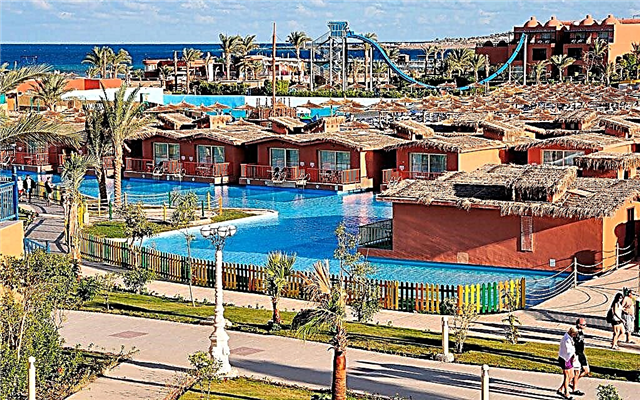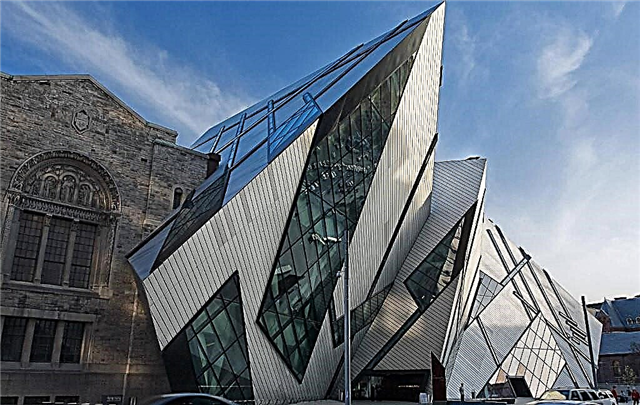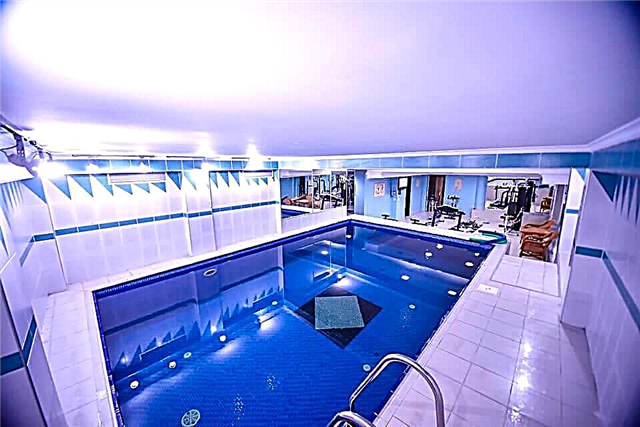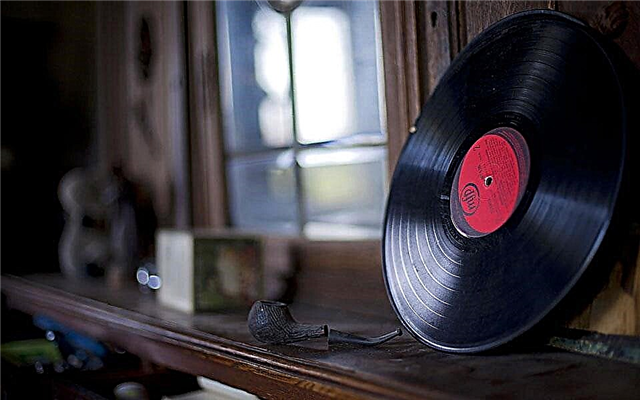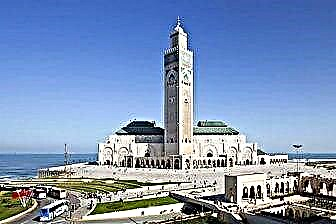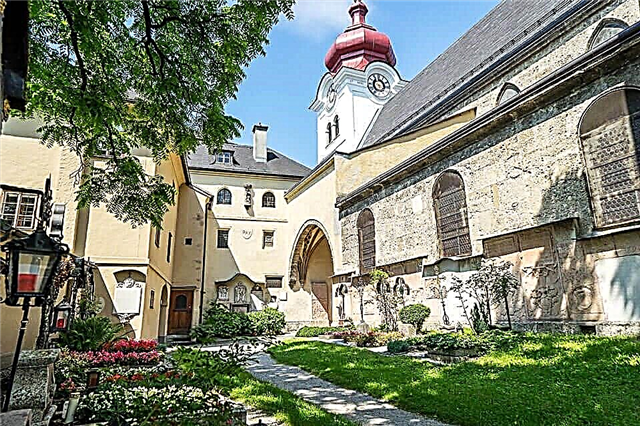Austria is deservedly considered a treasure trove of architecture, it is known for its sophistication. The cities can hardly be called "periphery", and the sights of Salzburg are a vivid confirmation, this is one of the cultural centers of Europe.
“Alpine Rome” is an ambitious task for architects, embodied in the Viennese Baroque style. Outposts, castles, temples, museums, streets and parks were built on donations from the Order of the Benedictines and the funds of the townspeople. Hometown of the genius Mozart, annual music festivals are held here.
This is music frozen in stone, which sounds like the chime of bells in Salzburg Square. For a long time it was Bavarian, but the redistribution of borders did not affect its splendor. The city is visited by up to a million tourists, many come back for new experiences.
Hohensalzburg Fortress

The main attraction is the Hohensalzburg Fortress. Built more than nine centuries ago, in an era of unceasing power struggle between the king and the pope, this fortress complex is the largest of its kind in Europe. For many centuries of existence of this huge fortress, Hohensalzburg performed not only a defensive function.
Within these walls, noble nobles took refuge from the anger of the people during the uprisings of peasants in the XV-XVI centuries, for some princes-archbishops the fortress served as a residence, and at the beginning of the XVII century the fortress became a place of imprisonment for noble persons.
Nowadays, everyone can visit the fortress to admire the picturesque ornaments of the Golden Hall and the Golden Chamber, as well as luxurious carvings made in the Gothic style. The splendor of the castle premises attracts artists from all over the world to Hohensalzburg, for whom from time to time courses of the International Summer Academy are held on the territory of the castle.
Mozart House Museum

All excursion routes lead to the "Dancemaster House" on Makartplatz. The Mozart family lived here from 1773 to 1787. Over time, the 8-room apartment was designed as a museum. The building once belonged to grocer Johan Hagenauer. Father V.A. Mozart acquired the position of court musician under the Archbishop of Salzburg. He became prosperous and successful, becoming famous as the best violin teacher, not only as the father of a little genius.
The violinist of the court chapel Leopold Mozart and a resident of the house number 9 settled with his family on the Geytergasse street on the 3rd floor. At this time, the first opus of the young Amadeus, who had a phenomenal musical memory, was published. He memorized and recorded exactly the polyphonic score "Miserere" of the Cathedral's chapel, whose sheet music was forbidden to rewrite and distribute.
In the city archives, this building is referred to as the "Dancemaster's House" (since 1713). Here a certain Lorenz Speckner gave dance lessons for the noble elite, preparing them to attend balls and social events. In October 1944, part of the house was damaged by an airstrike. It was restored for the International Mozarteum Foundation according to old drawings and memoirs of contemporaries.
Zoo

One of the oldest zoos in Europe was listed in the archives of the 16th century as a menagerie on the Helbrunn Hill for princely hunting. Later it was transformed into a city zoo. This site is listed in tourist guides as Tiergarten Hellbrunn, recommended for families with children.
During the Napoleonic Wars, animals were shot for food. Today, 800 individuals of 140 species live in a small area, mainly birds and mammals. The zoo was formed in a modern format in 1961. In the post-war period, young animals of the Alpine region - deer, wild boars, mouflons - were brought here. The concept was revised in 1990, representatives of the tropics were introduced, the animals were divided according to geographic principle.
Today there is a safari corner with African fauna, aviaries for representatives of Eurasia and South America. A pedestrian zone is equipped. The white rhino is the symbol of the zoo, but the kids are more into the alpaca and lemur house, a flock of pink flamingos and white peacocks. It is forbidden to feed the brought food, at the entrance they offer to buy specialized feed.
House of nature

Nature lovers should visit not only the zoo, but also visit the House of Nature. The local aquarium is one of the most beautiful aquariums in Central Europe. The magic of the underwater world in all its glory will open before visitors. Reef sharks, brightly colored tropical fish, fish from the Amazon and European waters make it possible to make an exciting underwater trip in a relatively short period.
In a separate part of the huge aquarium, 56 terrariums are equipped, in which poisonous snakes, lizards, frogs, alligators and turtles, representing reptiles and amphibians living in different parts of the world, feel at ease. In addition, there is a space hall in which you can see the space city, the planetary system and the structure of the Universe. Many exhibition halls acquaint visitors with the world of animals, minerals, representatives of the fauna and flora of the Ice Age and the nature of different continents.
Helbrunn Palace

The Hellbrunn Palace with its amusing fountains is considered one of the most attractive sights in the city. Designed as the summer residence of Archbishop Marcus Sittikus, the palace soon became a true architectural gem in the Renaissance style. The highlight of the palace was a vast park, in the shade of bushes and trees of which Amusing fountains were hidden. For 400 years now, these fountains, suddenly splashing moisture, have amused and at the same time frightened visitors to the palace. In addition to fountains, visitors are mesmerized by mysterious grottoes full of mysticism and mysteries.
Fountains, grottoes, luxurious palace halls since the founding of the residence began to attract a noble audience to Helbrunn for entertainment and various kinds of festive events. This tradition of lavish celebrations and unforgettable theatrical performances in the "Stone Theater", created on the site of a former stone quarry, continues to this day. Cultural events, seminars and conferences held within the framework of international events are regularly held in the territory of the palace park and in the palace.
Residenceplatz

Once upon a time salt was mined in these places and transported to different places, hence the name Salzburg (from "salz" - salt). The city is designed according to the European tradition, and the Residenzplatz is the Central Square. It owes its name to the residences of influential persons, princes-archbishops. The older building is on the west side, to the east is the white bell tower of the Glockenspiel tower of the New Residence.
From the south, the area is outlined by the walls of the Cathedral of St. Rupert and Virgil. From the north, the perimeter is closed by burgher mansions. The undoubted decoration of the square is the Residenzbrunnen - the oldest fountain designed by the Italian architect, built in 1661. The modern appearance of the Residenzplatz was formed in the second half of the 17th century, historical buildings have survived.
Tourists strolling around the city center at 7:00, 11:00 and 18:00 will have a pleasant surprise - classical music, including Mozart's melodies, played by bells. This is how the carillon instrument sounds, connected to the belfry of the New Residence. The tradition was established in 1704, this is a unique feature of the "musical Mecca" in the Alps.
Getreidegasse street

The heart of Old Salzburg throbs in Getreidegasse, where the former Grain Lane is. The genius of classical music, Wolfgang Amadeus Mozart, was born in a small apartment, where crowds of tourists aspire.There is a lot of interesting and unusual things in the antique shop, where you can have a delicious dinner and find out what real Viennese coffee is.
Thanks to local architects, the old buildings are organically combined with fashion boutiques and musical instrument salons. Walking along the historical part, you can get to the Cathedral Quarter. The Cathedral, the Residence of the Archbishop with the Monastery of St. Peter - the personification of the power of Salzburg.
The buildings of Getreidegasse gradually turned into a privileged area, but in the 14th century artisans and small traders lived here. Getreidegasse with the Cathedral Quarter is a UNESCO World Heritage Site. With 1 entrance ticket you can walk through 5 museums. The buildings in the Baroque style are also interesting inside, where the atmosphere of Medieval Europe reigns.
Mirabell Palace

An example of European landscape gardening architecture is the Mirabell Palace complex. Today it is the bottom of the most beautiful places, where everything is arranged according to the classic model. The Garden of Dwarfs was made separately for the children. The snow-white Schloss Mirabell Salzburg was built in 1606 for the prince-bishop Wolf Dietrich von Raithenau. He wanted a building outside the city, a summer residence, so as not to attract the attention of the townspeople to his life.
Initially, the Altenau Palace was intended for secret meetings of the nobleman with his beloved, Salome Alt. Rumors quickly reached the Pope, the archbishop was removed from affairs, his nephew became the successor of the meeting place of "forbidden love". He gave the estate a new name - Mirabell Palace (from Italian "very beautiful"). After rebuilding from the consequences of the fire in 1818, the building acquired new features. A courtyard and a garden and park complex appeared in the English style. Furniture and interiors are almost completely lost.
Open-air museum

A huge complex with an area of over 50 hectares. It attracts hundreds of thousands of visitors every year. There is no other place where you can learn in detail about the culture of the Austrians, see household items and learn about traditional crafts. The complex grew out of a small settlement, which was reorganized into an open area for an ethnographic exhibition. Historians have restored dozens of buildings. This is a church, school, mill, farm houses and craft shops.
The oldest exhibit is a building built in 1442. All of them were brought from different regions, they were disassembled and constructed in this park. Schoolchildren and students come here to study ethnography, excursions are held, families with children often visit. The magnificent nature and beauty of Salzburg complement the impression of what you see. A small train runs in a large-scale open-air museum, there is where to rest and refresh.
Gallery Residences

The art gallery is located in the Residence of the Salzburg rulers, in the pedestrian zone of the Old Town. In different rooms on the 3rd floor, you can see the works of Dutch, French and Italian schools of the 17th-19th centuries. The canvases of Rembrandt, Bruegel, Rubens, as well as the less well-known in our country Ender, Waldmüller and Amerling, are impressive.
Many celebrities have visited the Residence. Little Mozart surprised by the virtuoso playing of the archbishop himself. Dinner with Napoleon was shared by Emperor Franz Joseph. When the gallery was opened, it was a traveling exhibition from Munich. Over time, it was replaced by a stationary collection, and its own fund was formed.
European patrons took part in replenishing the collection. Some of the works were purchased from the collector Johann Rudolf Count Chernin. It was collected in Vienna from 1800 to 1845. The President of the Vienna Academy of Fine Arts possessed a collection of rare paintings by Flemish masters, the picture gallery is being replenished to this day.
Salzburg Cathedral

The Cathedral is the main religious building in the city center. It can accommodate 10 thousand parishioners. The building is visible from many points, thanks to the tower with a copper dome 79 m high. It cannot be confused with small churches and basilicas. The majestic facade of the Roman Catholic temple, decorated with sculptural figures of Biblical characters, is impressive in scale. The front door opens onto Domplatz.
The history of the Cathedral is full of events, which local guides willingly tell about. The first building is dated 774, in 1167 the church was burned to the ground, then it was repeatedly restored. The last project was implemented in 1614-1628. The cathedral is also notable for the fact of the baptism of Wolfgang Amadeus Mozart, but later he joined the Freemasons. Today this building with magnificent interior decoration is part of the cultural heritage of Austria.
Modern Art Museum

The most futuristic building in the city houses the Museum of Modern Art. It looks like a space object on Mount Mönchsberg above the rooftops of Old Salzburg. International art exhibitions are also held here. This is a multi-level building with an area of 2300 sq.m., where works of European artists of the XX - XXI centuries are exhibited
The museum was built in 2004, it is a competition project of the architectural bureau Friedrich Hoff and Zwink from Munich. The cladding used marble. There are many innovative solutions here, including glass staircases with panoramic views. The collection is constantly updated. Some of the city's paintings are exhibited in another building.
Here the works of young artists gained fame, these are Rebecca Horn, Ernst Haas, Erwin Wurm, Oskar Kokoschka. In parallel, unique photographs (over 17,000 works) are exhibited. Thematic exhibitions are regularly updated. Indoors there is a gift shop and a cozy art cafe.
Abbey of st peter

The monastery estates began to be built up back in the 7th century, at the initiative of the missionary Rupert, the patron saint of Salzburg. The city gradually expanded, the Abbey of St. Peter expanded. These include the catacombs, hermit cells, temple structures, an art gallery, and an old cemetery. Films based on historical subjects were filmed here.
The unique architectural ensemble has features of Romanticism, Renaissance and Baroque. In 1622, the Catholic University was opened within these walls, in the library of which rare manuscripts, notes of Mozart and Haydn were kept. Mozart's Mass in B minor, written for the monastery's services, is performed at musical events.
The oldest monastic order in German lands did not curtail its activities. The buildings of Stift Sankt Peter were destroyed and rebuilt after fires and raids by vandals. It is a typical monastery at the foot of the Mönchsberg mountain with its refectory, bakery and water mill. The former residence of the archbishops belongs to the monastery (partly open to visitors).
St. Peter's cemetery

Historically significant site - St. Peter's Cemetery. One of the oldest burial sites in Europe, where important persons and celebrities have found eternal rest. Their names are inscribed in the history of Austria in gold letters, although the gravestones and crosses look very modest. There are graves of priests, scientists, artists and musicians, the tombstone of Mozart's sister Nannerl.
The territory of St. Peter's Cathedral was built up in 1143, although only the foundation and basement have survived. The townspeople came here, V.A. Mozart. Some of the buildings of a later time, XVII-XVIII centuries. The territory of the cemetery remained untouched - a small piece of land under the wall of the Cathedral.
Gothic chapels, sculptural statues, Romanesque tombstones, wrought-iron fences and family crypts are of great interest. The oldest grave dates back to 803; it was a commoners' cemetery. Later, an order was issued that only important persons should rest at the Cathedral.
Nonnberg abbey

At the foot of the Fortress Hill stands the Benedictine abode of Nonnberg. The monastery is famous for its unique Gothic façade, wall paintings and ceiling frescoes.The multifaceted altarpiece with the Virgin Mary in the late Gothic style is a true treasure of the monks. Wall painting is the undoubted historical value of the religious building.
The Romanesque basilica was founded at the turn of the 1st and 2nd millennia, by order of Kaiser Henry II, it was consecrated in 1009. The first abbess of Nonnberg Abbey, Erentrud, was canonized as the patron saint of Salzburg. Her tomb is located in the rock crypt of the Church of Our Lady. This place rivals in beauty the collection of the Cathedral. The Crucifix dating back to 1300 is considered unique.
Much of the life of the monks is hidden from outsiders, but one story went beyond the walls of the monastery, inspiring the creation of the film "The Sound of Music". The novice of the monastery Maria von Kuchera, being a seconded governess, married the widowed baron. She organized a family choir, and this story formed the basis of the musical. Today it is a functioning nunnery, but only church buildings are open to the public.
Museum of Christmas

There are several similar Christmas Museums in Europe. The basis of Salzburg's exposition is Christmas tree decorations and Christmas symbols, gifts and wishes collected in the period from 1840 to 1940. Works in the former cafeteria "Courant", which was transferred to the museum in 2014. There is a New Year tree from the First World War, figurines for the fairy tale "Nutcracker", musical cards and mechanical toys to recreate the story of the birth of Jesus Christ.
Located in house number 2 (Mozart Square), it was bought by the media tycoon G. Kloyber for his wife Ursula, who was looking for premises for the exhibition "Pre-Christmas time". The collection impressed visitors to the Munich Museum in 2000. Ursula inherited part of the collection, part was bought and collected by fellow citizens.
Ursula Kloyber's collection has grown into the Museum of the Nativity. For about 40 years she has been collecting exhibits in memory of the happy times of her childhood. There are no modern toys and garlands here, all the exhibits are pre-war, calendars and postcards were made in the 1st half of the 20th century.
Exhibition pavilion Red Bull "Hangar-7"

Red Bull is a collection of aircraft in the area adjacent to the airport. The local aeronautics museum has gained popularity due to its exclusivity. The room is unique and rare specimens are all that can fly.
The hangar slabs form a geometric pattern, but these are metal supporting structures to support the dome. The hangar design and its collection are also very original. Basically, these are rare models of sports aircraft. Night blue illumination makes the subject mesmerizing. From time to time, Red Bull air shows are held over Lake Wolfgangsee with some of the museum's exhibits.
Inspection of aircraft is not the main thing, it is easy to feel like a pilot in a flight simulator. It is worth trying fusion cuisine in the unusual presentation of the local restaurant "Ikar". Their author is the award-winning Michelin-starred Chef of the Century.
Leopoldskron Palace

The splendid Leopoldskron Palace is visible on the southern outskirts. It has recently turned into an expensive hotel. Rococo architecture and interiors, a picturesque landscape of the foothills of the Alps, a small lake, a park area and the top of the Untersberg mountain on the horizon - this is what is worth going to these places for.
For Europeans, castles, palaces and ancient fortresses are not uncommon. Leopoldskron was built in 1736 for the family of Leopold Firmian, although at that time the bishop already owned the Residence, here he bequeathed to bury his heart. After his death, the owners changed several times. In 1918, it was bought out by a theater director who undertook a full-scale reconstruction.
Winston Churchill and other celebrities visited Leopoldskron. On weekends at the beginning of the twentieth century, the creative elite of Austria came here. They had the idea of an annual Salzburg Music Festival.
Franciscan Church

The Franciscan Roman Catholic Church is one of the most memorable Christian shrines. This is one of the oldest churches belonging to the Franciscan order. It is difficult to confuse it with other buildings, amazing Gothic architecture with baroque elements on a solid Romanesque foundation.
Once upon a time at the crossroads of trade routes was the Celtic settlement of Yuvavum. Later, dilapidated wooden buildings were replaced by the stone foundations of the Roman Catholic Church. After the fall of the Roman Empire, some of the temple buildings were destroyed. The restoration of the ruins of the region began in the 8th century. The churches of Salzburg were also revived. This building was burned as a result of the capture during the reign of Emperor Frederick Barbarossa in 1167.
The restoration of the church was taken up seriously only in 1223. A large-scale reconstruction was carried out in the 15th century, the building was complemented by a Gothic tower. Later, the bell tower was completed, which was ordered to be shortened - it turned out to be higher than the Cathedral. A baroque spire was added in the 19th century. Within the walls of the church there is one shrine, touching which (according to legend), everyone becomes a righteous person through the forgiveness of the patron saint.
Archbishop's residence

The history of the city has been embodied for many centuries by the Residence of the Archbishop of Salzburg. The building of 1120 is well preserved, it was reconstructed several times. In the 15th century, Wolf Dietrich von Reithenau was engaged in this. Today, an art gallery functions in the halls of the Old Residence.
The residence for a long time served the rulers of the city, who had both a princely title and a priestly rank. It was a place for official receptions and important meetings. This is a suite-type building, many rooms are connected by a common passage. Once upon a time, the Throne and Banquet Halls, secluded recreation apartments and other premises were planned here.
Today, visitors can get acquainted with part of the treasury of the Old Residence. Antique clocks and paintings, tiled stoves, Venetian mirrors, crystal chandeliers and candelabra, ceiling frescoes. Works by masters of different eras of high artistic value. Rembrandt's Portrait of a Praying Woman, where he portrayed his mother, is noteworthy.
Puppet theater

The Puppet Theater is not just a puppet theater, it is a whole direction in art. This is a cross between an opera house, "The Muppet Show" and a traditional Russian booth with Petrushka on hand, but in the European version. The local Puppet Theater is not a children's entertainment, but a form of art that rivals its counterparts from the traditional culture of Japan and China.
There are performances for children, but any enchanting performance delights spectators of all ages. From the first minutes it is not entirely clear whether this is a talented parody or a special embodiment of opera classics and dramatic plays. Puppets controlled by people "work" as actors.
The main staff of the Puppet Theater often tours around the world. Puppeteers with their characters are welcome guests of puppet theaters from different countries, they performed in Moscow and St. Petersburg. In 1971, the composition of the theater entered its own building. From the first minutes, the audience forget that they are dolls, and not real people and their characters.
Mount Kapuzinerberg

Opposite the Old Town by the Salzach River, tourists have the opportunity to take pictures with the Kapuzinerberg Mountain in the background. The name was entrenched from the monastery at its foot, the monastery of the Capuchin order. The buildings were reconstructed after the Napoleonic Wars, whose troops plundered and desecrated the Franciscan shrine.
There is an observation deck at the top of the mountain, where you can climb countless steps (the height of the rise is about 700 m). The magnificent panorama is the main goal of the ascent without funiculars and escalators. Along the way, there are interesting objects, including a bust of Mozart and scenes from the life of Christ, carved in stone.
Part of the walking tour is a wooded area with marked routes for those wishing to walk through the "wild" forest.There are few wild animals, roe deer and ibex, but they keep away from people. The alleys are equipped with benches for rest, it is better to take water with you. But upstairs there is a restaurant in the form of a hunting lodge with delicious treats.
Mount Untersberg

Not every high point in the vicinity of the city has a funicular. It is much easier to climb Mount Untersberg with the help of a modern "cable car". The summit is covered with fairy tales and legends, a stunning panorama opens, stretching literally under your feet. The aerial cable car has been transporting tourists since 1961. It carries up to 100 thousand passengers per year. At the top you feel like a giant or a powerful character of the European epic.
The Untersberg Mountain is almost 2000 meters high and has several hiking trails. The magnificent panorama of the foothills of the Alps and Salzburg with its surroundings is the main goal of the trip to the border of Austria and Germany. At the top of the mountain, guests are greeted by a restaurant, a cafeteria and a cozy recreation area, where you can eat and warm up in “bad” weather.
Volksgarten park

Carefully groomed by the hands of landscape designers, the Volksgarten is a great place to relax. The name translates as "folk", another, "imperial" name - Franz Josef Park. So they wanted to perpetuate the name of the Austrian monarch, who made a significant contribution to the economic and cultural growth of Austria.
People come here to relax in a quiet place where everything is pleasing to the eye. We can say that this is a green oasis in the middle of an urban culture. A large open-air pool, a golfing lawn, jogging paths and walking paths - everyone chooses to their liking.
The park is beautiful at night too. Those who are engaged in the arrangement of similar objects should learn the art of park lighting design, which was founded back in 1817. This is the embodiment of the idea of the architect Ludwig Remy. Its transformation has been carried out at all times. Manicured lawns, rose gardens, water lily ponds, sheared shrubs and wild trees are indescribable beauty at any time of the year.
St. Andrew's Church

The first building of San Andre was made in the Gothic style, later it had to be restored, it became neo-Gothic. Over time, she decorated the city with the appearance of the Renaissance. And after 1750, baroque elements appeared in the architectural appearance of the Church of St. Andrew, this was a single style solution for the architecture of Salzburg.
In 1818, she suffered from a fire; they wanted to demolish it in order to widen the roadway. The church was restored by expanding the old foundation. After the bombing of 1944, its original appearance was lost. Taking into account the wishes of the townspeople, the domes with crosses were restored, and the facade became light gray, organically blending into the urban landscape.
The church can be visited at any time. Nearby there is a convenient parking, opposite - the Mirabell Palace. Traditionally, on Thursdays opposite the church there is a grocery market, where they bring pastries, homemade smoked meats, cheeses and sausages. The Schrannenmarkt is a foodie's paradise.


